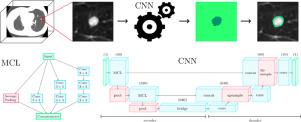Computer Methods and Programs in Biomedicine ( IF 4.9 ) Pub Date : 2020-10-15 , DOI: 10.1016/j.cmpb.2020.105792 Giuseppe Pezzano , Vicent Ribas Ripoll , Petia Radeva

|
Background and objective:An accurate segmentation of lung nodules in computed tomography images is a crucial step for the physical characterization of the tumour. Being often completely manually accomplished, nodule segmentation turns to be a tedious and time-consuming procedure and this represents a high obstacle in clinical practice. In this paper, we propose a novel Convolutional Neural Network for nodule segmentation that combines a light and efficient architecture with innovative loss function and segmentation strategy. Methods:In contrast to most of the standard end-to-end architectures for nodule segmentation, our network learns the context of the nodules by producing two masks representing all the background and secondary-important elements in the Computed Tomography scan. The nodule is detected by subtracting the context from the original scan image. Additionally, we introduce an asymmetric loss function that automatically compensates for potential errors in the nodule annotations. We trained and tested our Neural Network on the public LIDC-IDRI database, compared it with the state of the art and run a pseudo-Turing test between four radiologists and the network. Results:The results proved that the behaviour of the algorithm is very near to the human performance and its segmentation masks are almost indistinguishable from the ones made by the radiologists. Our method clearly outperforms the state of the art on CT nodule segmentation in terms of F1 score and IoU of and respectively. Conclusions: The main structure of the network ensures all the properties of the UNet architecture, while the Multi Convolutional Layers give a more accurate pattern recognition. The newly adopted solutions also increase the details on the border of the nodule, even under the noisiest conditions. This method can be applied now for single CT slice nodule segmentation and it represents a starting point for the future development of a fully automatic 3D segmentation software.
中文翻译:

CoLe-CNN:具有自适应损失功能的上下文学习卷积神经网络,用于肺结节分割
背景与目的:在计算机断层扫描图像中准确分割肺结节是对肿瘤进行物理表征的关键步骤。结节分割通常是完全手动完成的,因此这是一个繁琐且耗时的过程,这在临床实践中构成了很大的障碍。在本文中,我们提出了一种新颖的卷积神经网络,用于结节分割,它将轻巧高效的架构与创新的损失函数和分割策略相结合。方法:与大多数用于结节分割的标准端到端体系结构相反,我们的网络通过在计算机断层扫描中产生两个代表所有背景元素和次要重要元素的蒙版来学习结节的上下文。通过从原始扫描图像中减去上下文来检测结节。此外,我们引入了非对称损失函数,该函数可自动补偿结节注释中的潜在错误。我们在公共LIDC-IDRI数据库上训练并测试了我们的神经网络,并将其与最新技术进行了比较,并在四位放射科医生和网络之间进行了一次伪图灵测试。结果:结果证明,该算法的行为与人类的表现非常接近,其分割蒙版与放射科医生制作的蒙版几乎没有区别。在F1评分和IoU方面,我们的方法明显优于CT结节分割的最新技术。和 分别。结论:网络的主要结构确保了UNet体系结构的所有属性,而多卷积层则提供了更准确的模式识别。即使在最嘈杂的条件下,新采用的解决方案也可以增加结核边界的细节。该方法现在可以用于单个CT切片结节分割,它代表了未来开发全自动3D分割软件的起点。











































 京公网安备 11010802027423号
京公网安备 11010802027423号